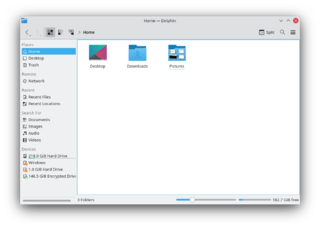Dolphin
 |
El administrador de archivos dedicado con talentos ocultos |
Resumen de características
A primera vista, es un simple administrador de archivos, pero tiene muchos talentos. Algunas características incluyen:
- Divide las ventanas - visualiza y utiliza dos directorios al mismo tiempo
- La visualización de los atributos puede ser configurada (y recordada) independientemente para cada ventana
- Navegación por pestañas
- Usa el panel de información opcional de la derecha
- O elige tener la información de los atributos esenciales mostrada en la ventana
- Utiliza la navegación por 'hilo de Ariadna' para mayor velocidad
- Cambia a la barra de direcciones editable con un solo clic
- Añade el panel de Carpetas para navegación tradicional
- Abre una terminal en el directorio en el que estés navegando
- Muchas funciones controladas por atajos del teclado
Tutoriales
Philosophy
Dolphin is a file manager focusing on usability. When reading the term Usability people often assume that the focus is on newbies and only basic features are offered. This assumption is wrong.
Target User Group
Focusing on usability means that features are discoverable and efficient to use. The feature set is defined indirectly by the target user group of Dolphin:
- Lisa: Lisa is familiar with computers since 10 years. Due to her job she has experience with Word, Excel and Outlook. At home she mainly uses the computer for browsing the web and writing e-mails. She requires a file manager for managing photos from the camera, documents she gets per e-mail or PDF-documents she downloads with a browser. Lisa knows concepts like folders and a file hierarchy, but she is not familiar with the file hierarchy of Linux.
- Simon: Simon has been a developer at a software company for 8 years. At home he uses a file manager to maintain his large collection of photos and music. Additionally he owns a small homepage and needs to transfer updated files on the FTP server. Moving and copying files are regular tasks in Simon's workflow.
Not part of the target user group of Dolphin are Fred and Jeff:
- Fred: Fred is 75 years old and is able to write e-mails and browsing the web. He is not familiar with file hierarchies and stores all his documents on the desktop.
- Jeff: Jeff is Linux-freak since the age of 16 a few years ago. He is developer and in his spare time he acts as administrator for a small company. Jeff has two monitors to keep the overview about his huge number of opened applications.
This does not mean that Fred or Jeff cannot work with Dolphin. But there might be features and concepts of Dolphin that overburden Fred. Also Jeff might miss some features which are a must-have for his daily work.
Non-Intrusive Features
Before a feature is added in Dolphin, it is checked whether the feature is mandatory for the target user group. If this is not the case, then this does not mean that the feature cannot be added; first it must be clarified whether the feature might be non-intrusive, so that it adds value for users outside the primary target user group of Dolphin. Non-intrusive is mainly related to the user interface. A feature that adds a lot of clutter to the main menu, context menus or toolbar might harm the target user group. In this case the feature will not be added.
A good example of a feature that is non-intrusive is the embedded terminal in Dolphin. It only requires one entry inside a sub menu, but adds great value for Jeff, who is not part of the target user group.
Options
Options are mandatory as the user "average Joe" does not exist. Still it is not the goal of Dolphin offering options for all kind of things. Again the focus is on the possible needs of the target user group. Each additional option makes it harder finding other options, so the same rules for features are applied to options too.
Consejos, Recomendaciones y solución de problemas
Problema: Las entradas del menú de Dolphin y/o no presentan ninguna opción. Nepomuk está activado en la configuración del sistema.
- Solución: Renombra la carpeta ~/.kde4/share/apps/dolphin (en algunas distribuciones es ~/.kde/share/apps/dolphin) y reinicia Dolphin. Esto limpiará la personalización de dolphin pero las entradas deberían volverse a ver. Si todo funciona como debería puedes borrar la carpeta. Esto me ocurrió a mi después de actualizar de KDE 4.4 a 4.5.
Problema: Cuando se escoge la aplicación a abrir para un determinado tipo de archivos, parece que afecta también a otros tipos de archivo. Parece que Dolphin no puede discernir la diferencia entre dos tipos de archivo diferentes".
- Solución: Probablemente la plataforma KDE no reconoce uno de los dos tipos de fichero, por lo tanto asocia el tipo de fichero a otro tipo de fichero conocido. Esto es común con tipos de fichero basados en XML; incluso si usan un tipo de fichero propio (por ejemplo .xliff o .graphml), si no son un tipo de fichero conocido por KDE, serán tratados como otro fichero XML, y se abrirán con la aplicación por defecto para abrir ficheros XML.
- Para resolver este problema, puede usar Asociaciones de archivos para crear una entrada para el tipo de archivo desconocido.
Problem: Dolphin's Find File service doesn't find files you know are on your computer.
- Solution: Reindex Baloo. Baloo is a file indexing and search service that Dolphin uses to search for files. It needs to be indexed to work. To solve this problem, in a terminal type, balooctl check
Also see forums and the Dolphin Handbook.
Palabras clave
Gestión de archivos, administrador de archivos, navegador de archivos, etiquetas, metadatos, Nepomuk
